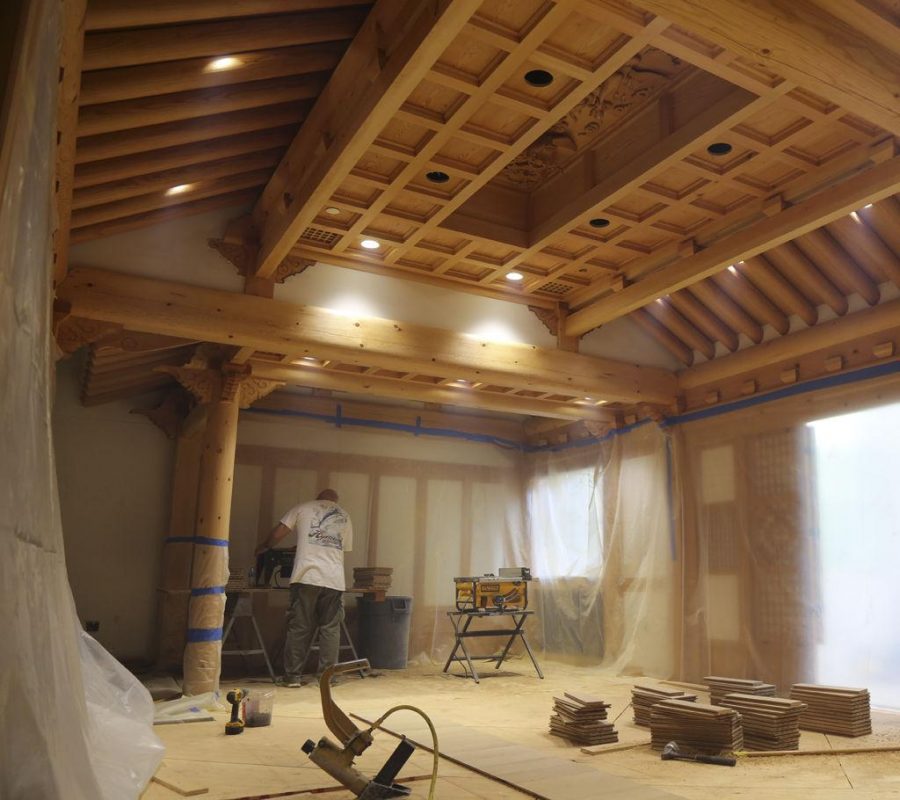It has taken nearly nine years and $850,000, but Pitt is almost ready to unveil its latest Nationality Room.
The Korean Heritage Room is the newest addition to the Cathedral of Learning Nationality Rooms, and its designers and carpenters have said they strived to build a room that would truly reflect Korean society and the nation’s educational settings.
Minah Lee, the Architect-of-Record and designer of the room, said she and the other designers wanted the construction of the room to revolve around Korean pride, or “jajonsim.” She, Myounghee Song, Kim Bong-ryol, and Sang C. Park, the other designers of the facility, worked through the summer on the room, which is scheduled to open on Nov. 15.
The room will feature an 82-inch interactive Samsung LCD to display lessons. The inclusion of such technology is the first for any of the Nationality Rooms.
The decision to include technology was made to commemorate South Korea and its role in the electronic industry.
“We are so proud to have the LCD in the room,” Park said, adding that chalkboards and the like could be very messy and time consuming.
Rather than creating a message through a façade, Lee said, the Korean Heritage Classroom “speaks through its special organization and structures”.
With the design in hand, workers in Korea individually constructed the pieces, including wooden beams, pillars and ceiling panels with hand carved traditional designs, before shipping them to Pittsburgh, where local workers assembled them in the Cathedral of Learning.
The Syria-Lebanon Room and the Japanese Nationality Room are the only other nationality rooms constructed in their countries of origin.
According to Bong-ryol, the traditional method of teaching in Korea does not revolve around instruction. Rather, it focuses on students realizing the outcome on their own, through the use of their creative thoughts. The teacher’s goal is simply to guide students in the right path.
“The spatial organization [of the Korean Heritage Room] helps convey that message,” Bong-ryol said. “Even if the students are in the classroom after lessons, they’ll look at the intricate details, joineries, or just the difficult way in which the structure was built, and get inspiration from that.”
The designer’s based the room of the Myung-Ryoon-Dang, or “Hall of Enlightenment,” in the Royal Palace of Seoul’s Joseon Era, where according to Bong-ryol, “100 students were taught in [the hall], sitting on the cold floor.”
The Arumjigi Culture Keepers, a Korean organization, contributed approximately $250,000 to build the Korean Heritage Room, in its first overseas project. A further contribution of $250,000 for the project came from The Korea Foundation, a group that sponsors cultural exchange.
Former Pitt Chancellor John Bowman began the legacy of the Nationality Rooms in 1926, when he asked Ruth Crawford Mitchell, Pitt’s first Nationality Rooms director, to invite different ethnic groups of Pittsburgh to create rooms in the Cathedral to represent the good they brought to the U.S.The rooms were built over the span of thirty years as a way to foster creativity among students, as well as obtain enough funding to complete the Cathedral.
At present, approximately 40,000 people visit the nationality rooms each year.
Nationality Rooms director E. Maxine Bruhns has now led the formation of 10 of the intricately designed rooms. At the age of 91, carrying on her work for society, she works with each ethnic group to create the best space to represent their culture and show her admiration for their work.
“I greet the workers with, ‘saranghaeyo,’ which means, ‘I love you’ in Korean,” Bruhns said.


